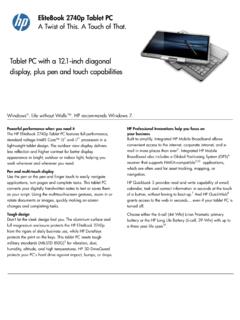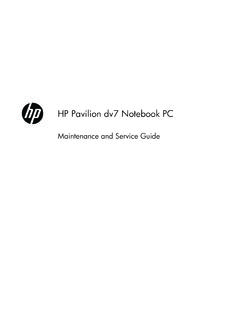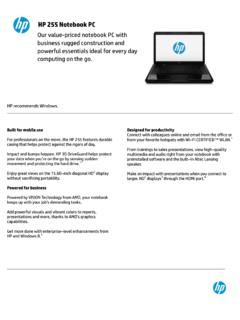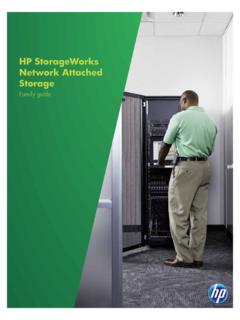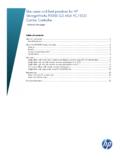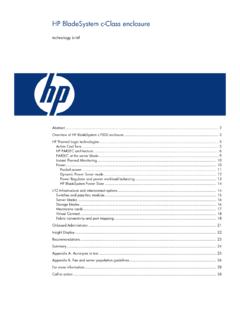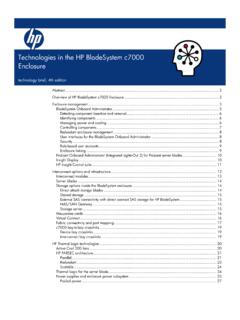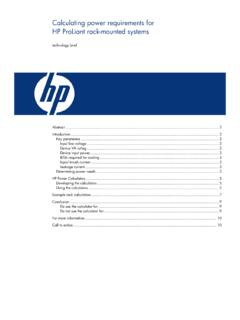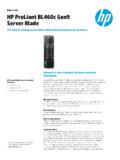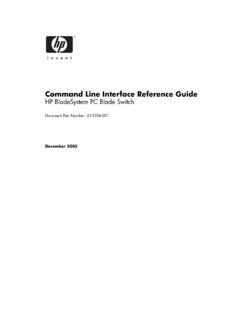Transcription of HP StorageWorks MSA2000 G1 or G2 and P2000 G3 FC MSA
1 HP StorageWorks MSA2000 G1 or G2 and P2000 G3 FC MSA Best practices Technical white paper Table of contents About this document .. 3 Intended audience .. 3 The MSA2000 G1 .. 3 Topics covered .. 3 Hardware overview .. 4 iSCSI, Fibre Channel, or SAS .. 5 Unified LUN Presentation (ULP) .. 5 Fault tolerance versus performance on the MSA2000fc G1 .. 7 Choosing single or dual controllers .. 8 Choosing DAS or SAN attach .. 9 Dealing with controller failovers .. 10 Virtual disks .. 17 RAID levels .. 19 World Wide Name (WWN) naming conventions .. 21 Cache configuration .. 22 Fastest throughput optimization .. 26 Highest fault tolerance optimization .. 26 The MSA2000 G2 .. 27 Topics covered .. 27 What s New in the MSA2000 G2 .. 27 Hardware overview .. 28 Unified LUN Presentation (ULP).
2 29 Choosing single or dual controllers .. 30 Choosing DAS or SAN attach .. 31 Dealing with controller failovers .. 32 Virtual disks .. 35 Volume 38 Configuring background scrub .. 38 RAID levels .. 39 Cache configuration .. 40 Fastest throughput optimization .. 42 Highest fault tolerance optimization .. 43 Boot from storage considerations .. 43 MSA70 considerations .. 43 Administering with HP SMU .. 44 MSA2000i G2 Considerations .. 44 The P2000 G3 MSA .. 45 Topics covered .. 45 What s New in the P2000 G3 MSA .. 45 Hardware overview .. 45 P2000 G3 MSA Settings .. 46 Disk Background Scrub, Drive Spin Down, and SMART .. 48 Cascading Array Enclosures .. 52 8 Gb Switches and SFP transceivers .. 54 Software .. 54 Versions .. 54 Description .. 54 HP StorageWorks P2000 Modular Smart Array Software Support/Documentation CD.
3 55 Host Server Software .. 55 Best Practices for Firmware Updates .. 56 General P2000 / MSA2000 Device Firmware Update Best Practices .. 56 P2000 / MSA2000 Array Controller or I/O Module Firmware Update Best Practices .. 57 P2000 / MSA2000 Disk Drive Firmware Update Best Practices .. 57 Summary .. 58 For more information .. 58 3 About this document This white paper highlights the best practices for optimizing the HP StorageWorks MSA2000 G1, MSA2000 G2, and the P2000 G3 MSA, and should be used in conjunction with other HP StorageWorks Modular Smart Array manuals. Modular Smart Array (MSA) technical user documentations can be found at Intended audience This paper is intended for entry-level and mid-range HP StorageWorks MSA2000 G1, MSA2000 G2, and P2000 G3 MSA administrators and requires previous SAN knowledge.
4 This document offers Modular Storage Array facts that can contribute to an MSA best customer experience. This paper outlines a best practice approach to performance and configuration. The paper is broken into three sections: 1. MSA2000 G1 best practices 2. MSA2000 G2 best practices 3. P2000 G3 MSA best practices The MSA2000 G1 Topics covered This section examines the following: Hardware overview Choosing between iSCSI, Fibre Channel, and SAS Fault Tolerance versus Performance Unified LUN Presentation (ULP) Choosing single or dual controllers Choosing DAS or SAN attach Dealing with controller failures Virtual disks RAID levels World Wide Name (WWN) naming conventions Cache configuration Fastest throughput optimization Highest fault-tolerance optimization 4 Hardware overview HP StorageWorks 2000fc G1 Modular Smart Array The MSA2000fc G1 is a 4 Gb Fibre Channel connected 2U storage area network (SAN) and direct-attach storage (DAS) solution designed for small to medium-sized deployments or remote locations.
5 The G1 model comes standard with 12 Large Form Factor (LFF) drive bays, able to simultaneously accommodate enterprise- class SAS drives and archival- class SATA drives. Additional capacity can easily be added when needed by attaching up to three MSA2000 12 LFF bay drive enclosures. Maximum raw capacity ranges from TB SAS or 12 TB SATA in the base cabinet, to over TB SAS or 48 TB SATA with the addition of the maximum number of drive enclosures and necessary drives. The MSA2000fc G1 supports up to 64 single path hosts for Fibre Channel attach. HP StorageWorks 2000i G1 Modular Smart Array The MSA2000i is a 1 Gb Ethernet (1 GbE) iSCSI connected to 2U SAN array solution. The MSA2000i also, like the MSA2000sa, allows you to grow your storage as demands increase up to TB SAS or 48 TB SATA, supporting up to 16 hosts for iSCSI attach.
6 The MSA2000i offers flexibility and is available in two models: A single controller version for lowest price with future expansion and a dual controller model for the more demanding entry-level situations that require higher availability. Each model comes standard with 12 drive bays that can simultaneously accommodate enterprise- class SAS drives and archival- class SATA drives. Additional capacity can be easily added when needed, by attaching up to three MSA2000 12 bay drive enclosures. HP StorageWorks 2000sa G1 Modular Smart Array The MSA2000sa is a direct-attach 3-Gb SAS-connected 2U solution, designed for small to medium-sized deployments or remote locations. The MSA2000sa is also used as an integral part of the Direct Attach Storage for HP bladesystem , bringing SAS direct attach storage to the HP bladesystem c- class enclosures.
7 The MSA2000sa comes in two models a basic single controller model for low initial cost with the ability to upgrade later and a model with dual controllers standard for the more demanding entry-level situations that require higher availability. Each model comes standard with 12 drive bays that can simultaneously accommodate enterprise- class SAS drives and archival- class SATA drives. Additional capacity can easily be added by attaching up to three MSA2000 12-bay LFF drive enclosures. Maximum raw capacity ranges from TB SAS or 12 TB SATA in the base cabinet, to TB SAS or 48 TB SATA with the addition of the maximum number of drives and drive enclosures. The MSA2000sa supports up to four hosts for SAS direct attach or 32 hosts for switch attach in the bladesystem configuration.
8 5 iSCSI, Fibre Channel, or SAS When choosing the right HP StorageWorks MSA2000 model, you should determine your budget and performance needs. Each model has unique features that should be weighed when making your decisions. Each model has some distinct characteristics. Characteristics of the MSA2000i G1 model: iSCSI uses the Transport Control Protocol (TCP) for moving data over Ethernet media Offers SAN benefits in familiar Ethernet infrastructure Lowers infrastructure cost Lowers cost of ownership Characteristics of the MSA2000fc G1 model: Offers a faster controller for greater performance The Fibre Channel controllers support 4 Gb for better throughput Integrates easily into existing Fibre Channel infrastructure More scalability, greater number of LUNs, and optional snapshots Characteristics of the MSA2000sa G1 model: Supports ULP (Unified LUN Presentation) No need to set interconnect settings Lower cost infrastructure Unified LUN Presentation (ULP) The MSA2000sa G1 uses the concept of ULP.
9 ULP can expose all LUNs through all host ports on both controllers. ULP appears to the host as an active-active storage system where the host can choose any available path to access a LUN regardless of vdisk ownership. ULP uses the T10 Technical Committee of the InterNational Committee for Information Technology Standards (INCITS) Asymmetric Logical Unit Access (ALUA) extensions, in SPC-3, to negotiate paths with aware host systems. Unaware host systems see all paths as being equal. Overview ULP presents all LUNS to all host ports Removes the need for controller interconnect path Presents the same World Wide Node Name (WWNN) for both controllers Shared LUN number between controllers with a maximum of 512 LUNs No duplicate LUNs allowed between controllers Either controller can use any unused logical unit number ULP recognizes which paths are preferred The preferred path indicates which is the owning controller per ALUA specifications Report Target Port Groups identifies preferred path Performance is slightly better on preferred path 6 Write I/O Processing with ULP Write command to controller A for LUN 1 owned by Controller B The data is written to Controller A cache and broadcast to Controller A mirror Controller A acknowledges I/O completion back to host Data written back to LUN 1 by Controller B from Controller A mirror Figure 1.
10 Write I/O Processing with ULP Read I/O Processing with ULP Read command to controller A for LUN 1 owned by Controller B: Controller A asks Controller B if data is in Controller B cache If found, Controller B tells Controller A where in Controller B read mirror cache it resides Controller A sends data to host from Controller B read mirror, I/O complete If not found, request is sent from Controller B to disk to retrieve data Disk data is placed in Controller B cache and broadcast to Controller B mirror Read data sent to host by Controller A from Controller B mirror, I/O complete Figure 2: Read I/O Processing with ULP Controller A Controller B A read cache B read mirror A write cache B write mirror A read mirror B read cache A write mirror B write cache LUN 1 B Owned Controller A Controller B A read cache B read mirror A write cache B write mirror A read mirror B read cache A write mirror B write cache LUN 1 B Owned Controller A Controller B A read cache B read mirror A write cache B write mirror A read mirror B read cache A write mirror B write cache LUN 1 B Owned Controller A Controller B A read cache B read mirror A write cache B write mirror A read mirror B read cache A write mirror B write cache LUN 1 B Owned 7 Fault tolerance versus performance on the MSA2000fc G1 Depending on whether performance or fault tolerance (where redundant components are)
